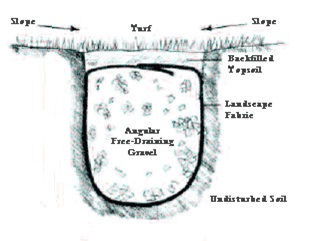Categories
Calendars
Guides
Reviews
Archive
Gallery
Articles
Ask Our Gardening Expert
Drainage
Remember that the land is dynamic and gardens no less so. a large tree can take up a thousand litres of water a day and soil water levels can be affected by works some way off. We are not dealing with occasional damp patches where we grow plants that tolerate wet conditions or broken water and sewage mains. Rather, ponding that remains after more than a day or so, many times during the year. Excessive surface water is a problem that needs to be solved. Good drainage allows a wider range of plants and allows you the continued enjoyment of your garden.
If only a small area is affected, raising the area about 30cm through the addition of topsoil is an easy solution. For larger areas, some form of in-soil drainage is called for. Remember that you’re not allowed to direct water on to a neighbour’s property or to a sewer which is not designed to take stormwater. There are a number of things you can do to avoid having to install complicated and expensive systems.
A Simple Dry Well
A French drain is a gravel drain with or without a pipe. The water collects from a wider area and is moved along a stone filled channel that starts on or just below the surface. The water can be directed to a stormwater drain or to an enlarged dry well. Before digging any trenches, find out from your local authority if there are any buried cables and pipes and at what depth, then decide what is to be done with the soil. Work out a ‘fall’ for the trench, water will not flow up hill. A fall of a few centimetres every metre is usually enough.
Drainage never seems to be a garden problem until you have bought your house and settled in. Until that time, you may not have viewed the property after heavy rain or the need may not arise until some nearby trees have been felled. 
A simple dry well is a hole filled with gravel and will easily clear small spots of water by filling quickly and dispersing the water through the subsoil around or beneath it. It can be dug by hand with a long handled shovel or a post-hole auger. Make a note of the subsoil that comes out. If it is clay, the hole may need to be deepened to beyond the clay layer. If you can find some polypropylene sacks, place one in the hole, fill it with gravel, tie the top and let the bag drop into the hole. Drop in another bag until the hole is filled to 20cm below the surface and fill in the rest with soil. One may be enough and if not, another can be dug nearby.